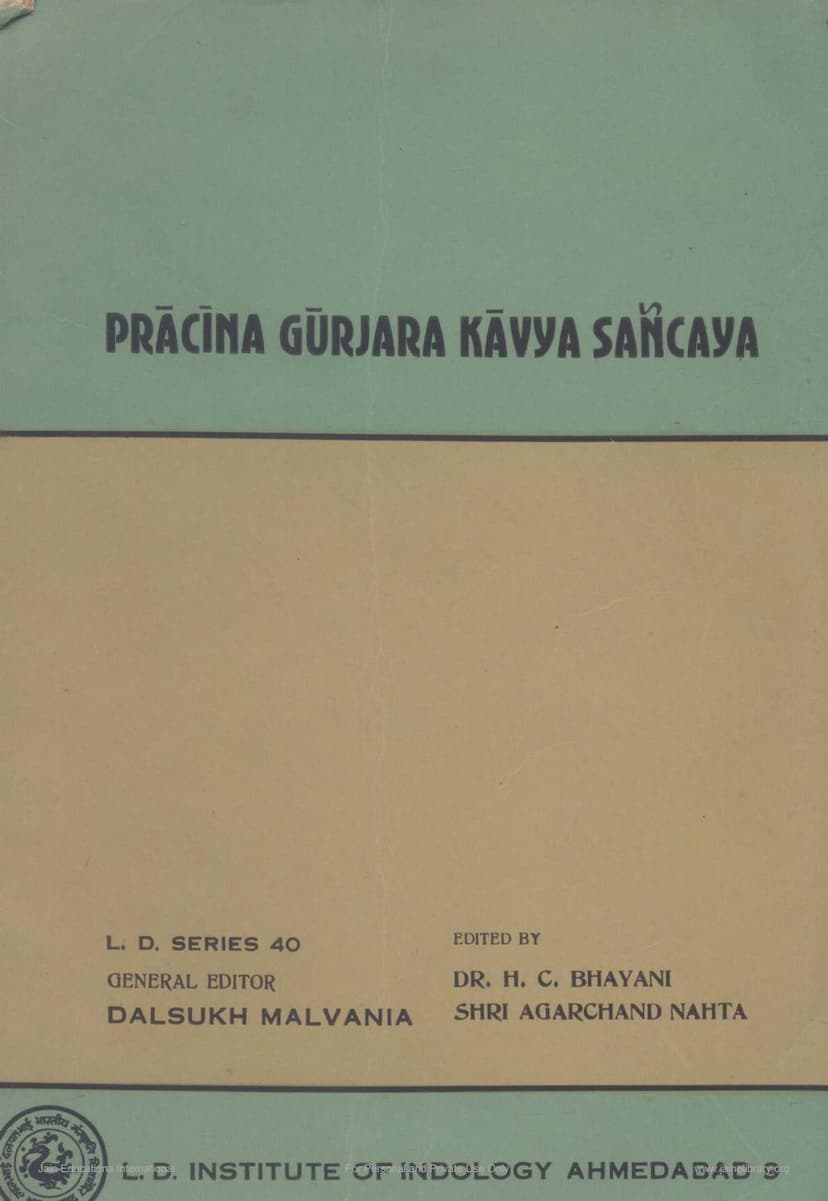Prachin Gurjar Kavya Sanchay
Added to library: September 2, 2025

Summary
This is a comprehensive summary of the Jain text "Prachin Gurjar Kavya Sanchay" based on the provided pages:
Book Title: Prachina Gurjara Kavya Sanchaya (प्राचीन गूर्जर काव्य सञ्चय) Author(s): H.C. Bhayani, Agarchand Nahta Publisher: L. D. Indology, Ahmedabad L.D. Series: 40 General Editor: Dalsukh Malvania Publication Date: First Edition, June 1975
Overview:
"Prachina Gurjara Kavya Sanchaya" is a collection of ancient Gujarati (Gurjar) literary works, meticulously edited by Dr. H.C. Bhayani and Shri Agarchand Nahta. Published by the L.D. Institute of Indology, Ahmedabad, this volume aims to bring to light significant poetic compositions that have been preserved in Jain Bhandars (collections) across Gujarat and Rajasthan. The collection is considered crucial for the study of the evolution of modern Gujarati and Rajasthani languages, as it includes works dating from the 14th to the 19th centuries, with a particular focus on material from the 13th century.
Key Aspects and Contents:
-
Purpose and Significance:
- The primary goal of this collection is to provide valuable material for scholars of literature and linguistics.
- It fills a crucial gap by preserving not only Sanskrit, Prakrit, and Apabhramsha texts but also the precursors of modern Gujarati and Rajasthani literature.
- The anthology is particularly important for understanding linguistic development, offering authentic texts based on ancient manuscripts.
- It is published with financial assistance from the Government of India, Ministry of Education and Social Welfare (Department of Culture).
-
Content:
- The book contains a total of 40 distinct literary works.
- These works span various genres and styles, including:
- Sandhi: (e.g., Kesi-Goyama-Sandhi, Namayasundari-Sandhi, Shila-Sandhi) - These often involve dialogues or narratives.
- Ghor: (e.g., Bharheser-Bahubali Ghor) - Likely epic or narrative poems.
- Ras: (e.g., Jivdaya-Ras, Chandanbala-Ras, Abu-Ras, Gaysukumar-Ras, Neminath-Ras, Mahavir-Ras) - These are narrative poems, often in a lyrical style, detailing stories of religious figures or events.
- Vastu: (e.g., Jambuswami-Shataka-Vastu) - Narrative or didactic verses.
- Phagu: (e.g., Jinachandrasuri-Phagu, Siri-Thulisbhadra-Phagu) - A genre known for its depiction of spring and romantic themes.
- Chatushpadaka, Barahmasa: (e.g., Neminath-Chatushpadaka, Nemi-Barahamasa) - Poems based on four-line verses or describing the twelve months.
- Boli, Bolika: (e.g., Neminath-Boli, Thulibhadra-Muni-Varnana-Boli, Shantinath-Bolika) - Shorter lyrical pieces, possibly devotional songs.
- Kalash: (e.g., Sarvajin-Kalash, Yugadidev-Kalash, Virjin-Kalash) - Concluding or celebratory verses, often in the form of a pitcher.
- Janmabhishek: (e.g., Mahavir-Janmabhishek) - Descriptions of birth rituals or celebrations.
- Samvad: (e.g., Krupan-Grihini-Samvad) - Dialogues.
- Prakirna Doha: Miscellaneous couplets.
- Dandadu: A specific genre (numbered 39).
- Navkar-Phal-Stavan: A devotional hymn glorifying the Navkar mantra.
-
Manuscript Sources:
- The editors relied heavily on manuscript collections found in various Jain Bhandars, including those in Bikaner, Jaisalmer, Jodhpur, Ahmedabad, Agra, and Patan.
- The collection process involved painstaking efforts to locate and copy these rare manuscripts, some of which were incomplete or damaged.
- The oldest palm-leaf manuscripts date back to the 12th century, while paper manuscripts are found from the 14th to the 16th centuries.
- The preface details the provenance of many works, citing specific Bhandars and manuscript numbers (e.g., Bikaner Brahad Gyanbhandar, Jaisalmer Panchayati Bhandar).
-
Linguistic Features:
- The language of the collected works is primarily Prachina Rajastani or Junī Gujarati, also referred to as Maru-Gurjar.
- The text notes the evolution of language from Apabhramsha, highlighting regional variations and the gradual divergence of Rajasthani and Gujarati from the 15th century onwards.
- Specific linguistic details discussed include:
- Phonetic Changes: Nasalization at the end of words becoming weak or disappearing, loss of 'h' in suffixes, regional changes like 'm' to 'v' between vowels, and vowel changes like 'ay' to 'iy'.
- Morphological Changes: The use of various verb and noun endings, including older Prakrit forms and emerging new suffixes. The text provides examples of verb conjugations (e.g., present participle, imperative, future) and noun case endings.
- Lexicon: A glossary of important words is included.
- Dialectal Influences: The language shows a mixture of ancient, contemporary, and later linguistic usages.
-
Poetic Forms and Metres (Chandorachana):
- The collection showcases a rich variety of poetic structures. The "Chandorachana" section meticulously describes the metrical patterns used in various compositions.
- Common metres mentioned include Doha, Vadanaka, Ghaṭṭa, Paddhati, Madanavata, Soratha, Vastuvadanaka (Rolla), Tribhadi, Apadoahaka, Bhas, Fag, Chaupadi, Barahmasa, Vivahala, Dhavala, Talhara, Boli, Kalash, Janmabhishek, Samvad.
- The text details the quantitative and syllabic structures of these metres, including the arrangement of ganas (metrical feet) and matras (syllables).
- Many of these compositions were intended for singing and were likely performed with music and possibly dramatic elements in temples or religious gatherings.
-
Authors and Time Periods:
- The works are attributed to various Jain scholars and poets, including Asig, Palhan, Delhan, Upadhyaya Vinayaprabha, Lakshmitilaka, Abhayatilaka, Jinapadmasuri, Vinayachandrasuri, Depal, Jinnesvara Suri, Jinavallabha Suri, and Jinaprabhasuri.
- The dating of these works is primarily based on manuscript colophons and internal evidence, placing most of them between the 13th and 15th centuries CE.
- The preface also includes brief biographical information about some of the prominent poets.
-
Historical and Cultural Significance:
- Some of the collected works hold historical value by providing details about Jain temples, their consecration ceremonies, and important historical figures (e.g., Shantinath Jainalaya in Khed, Mahavir Jainalaya in Bhimpalli, Abu-Ras).
- The literature offers insights into the social and religious life of the period.
-
Editorial Work:
- The editors, Dr. H.C. Bhayani and Shri Agarchand Nahta, collaborated extensively on this project. Bhayani undertook the linguistic analysis and selection, while Nahta provided access to manuscripts and contributed to the overall compilation.
- The editors acknowledge the immense effort involved in collecting, transcribing, and editing these texts, especially considering the condition of some manuscripts.
In essence, "Prachina Gurjara Kavya Sanchaya" is a monumental academic undertaking that preserves and presents a rich tapestry of medieval Jain literature, crucial for understanding the linguistic, literary, and cultural heritage of Gujarat and Rajasthan.